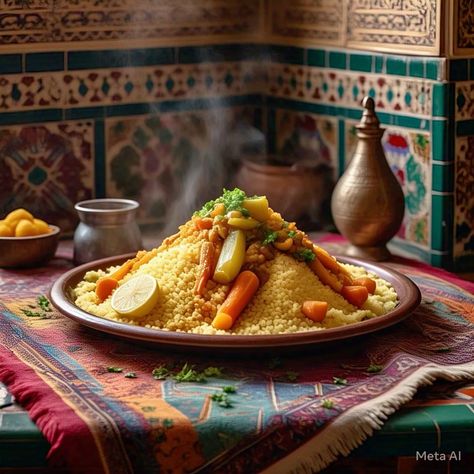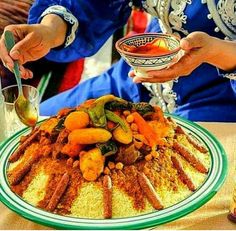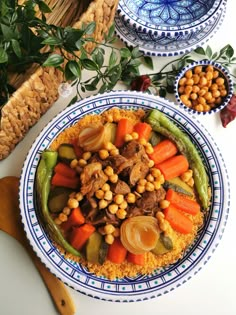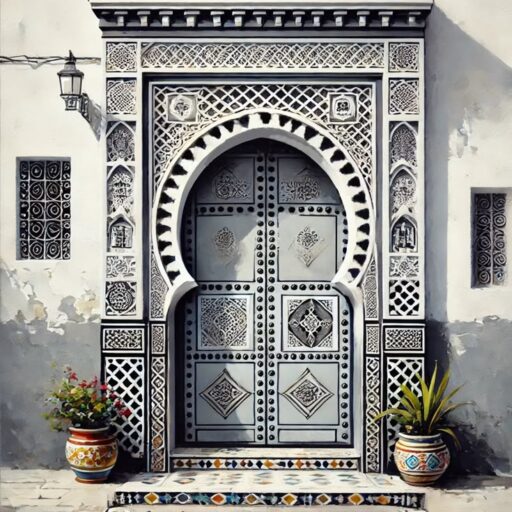
Prepare the Meat and Broth
In a large pot, heat the oil and brown the meat with the spices (turmeric, ginger, pepper, and salt).
Add the chopped onion and cook until softened.
Add the chickpeas, parsley/cilantro bouquet, and water. Bring to a boil, then reduce the heat and simmer for 30 minutes.
Steam the Couscous:
Place the couscous in a large bowl and drizzle with a little oil. Rub the grains between your hands to separate them.
Transfer the couscous to a steamer basket and steam over the pot for 15 minutes.
Remove the couscous, sprinkle with water, and fluff with a fork. Repeat the steaming process twice more for light, fluffy couscous.
Cook the Vegetables:
Add the carrots, turnips, and pumpkin to the pot with the meat. Cook for 15 minutes.
Add the zucchini and cabbage, and continue cooking until all the vegetables are tender.
Assemble the Dish:
Arrange the steamed couscous on a large platter, forming a mound.
Place the meat in the center and arrange the vegetables around it.
Drizzle the broth over the couscous and serve hot.
This dish is traditionally served family-style, with everyone sharing from the same platter.
What Makes Moroccan Couscous Special?
At its heart, Moroccan Couscous consists of tiny semolina grains that are carefully steamed to achieve a light, fluffy texture. The dish is typically served with a savory broth made from seasonal vegetables, chickpeas, and tender meat—whether lamb, beef, or chicken. The flavors are brought to life with iconic Moroccan spices like saffron, ginger, and ras el hanout, a unique spice blend that varies from region to region.
Some variations also include a touch of sweetness, with the addition of raisins, dried apricots, or caramelized onions, creating a perfect harmony of flavors.

The Ritual of Friday Couscous
In Morocco, Fridays are sacred for family and community. After the Friday prayers, families gather around a large communal platter of couscous. The meal is served family-style, with everyone eating from the same dish—a tradition that reinforces unity and sharing.
The arrangement of couscous is an art form in itself: the semolina forms the base, while the vegetables and meat are beautifully arranged on top. To complete the meal, diners use freshly baked khobz (Moroccan bread) to scoop up the rich, flavorful broth.
A Dish that Transcends Time
Couscous is not only a culinary masterpiece but also a reflection of Morocco’s rich history and cultural diversity. It has roots in Berber traditions, with influences from Arab, Andalusian, and even Mediterranean cuisines. Its preparation and flavors may differ slightly across regions, but its significance remains universal.
A Taste of Morocco at Home
Making Moroccan Couscous at home is a rewarding way to connect with this beautiful culture. The secret lies in the patience and love poured into its preparation—steaming the semolina to perfection and layering it with vibrant vegetables and succulent meat. It’s a meal that invites you to slow down, savor, and appreciate the beauty of shared experiences

Celebrating Tradition: The Story of Moroccan Couscous
Celebrating Tradition The Story of Moroccan Couscous
Moroccan Couscous, or “seksu” as it’s called locally, is more than just a dish—it’s a symbol of Moroccan heritage, hospitality, and community. Recognized by UNESCO as an Intangible Cultural Heritage of Humanity, couscous is a beloved staple that has been passed down through generations, uniting families and friends around a shared table.1
Moroccan Couscous is a beloved dish that embodies the essence of Moroccan culture and hospitality. Known locally as “seksu,” it is a staple of Moroccan cuisine, deeply rooted in tradition and history. Couscous is typically made from steamed semolina grains, which are prepared to achieve a light and fluffy texture. It is often served with a savory broth, featuring tender meat such as lamb or chicken, chickpeas, and a colorful array of vegetables like carrots, zucchini, turnips, and pumpkin.

The dish is seasoned with a blend of aromatic spices, including ginger, saffron, cinnamon, and ras el hanout, which give it its distinctive flavor. Some variations include dried fruits like raisins or apricots, preserved lemons, and a drizzle of olive oil for a sweet and savory harmony. Couscous is traditionally arranged on a communal platter, symbolizing unity and abundance, with the semolina forming the base and the meat and vegetables carefully placed on top.
Couscous holds a special place in Moroccan life, often served during Friday family gatherings, weddings, and festive occasions. It is more than just a meal—it is a celebration of community, heritage, and blessings. UNESCO has even recognized Couscous as an Intangible Cultural Heritage of Humanity, highlighting its significance across North Africa.
WITH VEGETABLES Restaurant & Cafe

